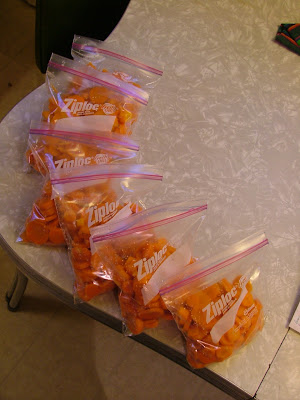Wikipedia defines the
Butterfly Effect as "small variations of the initial condition of a dynamical system may produce large variations in the long term behavior of the system."
It appears that this chaos theory has been working itself out in my kitchen over the course of the last week.
It's sort of like that children's book "
If You Give a Mouse a Cookie..." The premise of the book is that by engaging in one initial action of giving a mouse a cookie, a chain of complicated reactions snowballs into an afternoon adventure with a very demanding mouse. Because of course... If you give a mouse a cookie, then he'll probably ask for a glass of milk, then he'll want to take a bath to clean off his milk mustache, and so on and on and on.
So enter the one thing that has produced large variations in the behavior of my kitchen system: the electric ice cream maker.
The first tiny fluttering of butterfly wings happened several weeks ago, when
Frivolous Diane happened to mention making her own ice cream. I was intrigued.
"Would it be worth it to get an ice cream maker?" I asked.
"For you, yes," she replied. "Because the point of making your own ice cream is making flavors you can't buy in the store."
If you tell a foodie she should have an ice cream maker, and garage sale season in Bowling Green happens to be in full swing, and she see a mint condition, used Krups model#358 electrice ice cream maker for sale, and she happen to talk the seller down in price by $5, and gets the seller to throw in the "
Willam Sonoma Kitchen Library Ice Creams and Sorbets" cookbook for free, then she'll probably bring home an ice cream maker.
If she brings an ice cream maker home, her husband will probably want to make his own dark chocolate gelato, an incredibly rich and creamy gelato that requires an excessive amount of cream and egg yolks. If her husband tries to make dark chocolate gelato, (from the "Ice Creams and Sorbets" Cookbook) he'll probably use the Kitchen Aid mixer to beat the 5 egg yolks and sugar together. This, of course, will result in over-beaten, frothy and ruined gelato mix and a surplus of 5 egg whites just laying around.
If her husband messes up the recipe once, he'll probably want to try it again, just to prove he can get it right. So, he'll make it a second time, but this time, after NOT over beating the egg yolks, he'll overcook the gelato mix, and it will separate into a gloopy, curdled mess, and raise the number of surplus egg whites laying around to 10.
If her husband messes up the recipe twice, he'll probably say to himself, "third time's a charm," and try again. So, he'll make it a third time. But this time it will come out perfect.

But this still does not make up for the fact that there are now 15(!) egg whites laying around that this foodie must find a use for.
"What's a foodie to do?" I asked myself.
These were local, free-range eggs. Eggs bought from local egg lady, eggs that came from happy, healthy chickens that I have met personally. I couldn't bear to throw them away.
I made ersatz coconut macaroons, which were delicious, but only used up 2 egg whites. Egg white count: 13.
Then, I made Orangette's amazing
Chocolate Featherweight Cookies, but still that only depleted my egg white stock by 4. Egg white count: 9.
So finally, I sucked it up and made French-style Meringues. I have had an aversion to meringues ever since I ate a store bought one. The experience was akin to eating sugared cardboard balls. And like my husband, I had a couple of culinary failures under my belt. Mine involved meringues though and not gelato. But, I had come to my wit's end trying to get creative with egg white use. So, I gave it a whirl...
And, honestly, those meringues were one the best confections that have come out of my kitchen in a long time. Meringues are finicky though. I knew that, so I proceeded with caution. First of all, meringues do not like humidity. If you make them on a rainy day, you are asking for failure. Next, they really can't be rushed. They like to take their sweet little time, which means baking them for 1 hour, and then turning off the oven and letting them rest for at least another 6 hours, or overnight.
So perhaps, it was the Christmas-morning-like anticipation that made me fall in love with these cookies because really, there is nothing better than going to sleep to the smell of vanilla and sugar and waking up to a cold oven full of meringues, and promptly eating, say half and dozen or so of them for breakfast.
The meringues, I found, are surprisingly addictive. They have a pleasing, crisp crunch on the outside, and a seductive, slightly chewy interior. And their sweet vanilla flavor is nothing short of haunting. Next time you have some egg whites lying around, I highly recommend making meringues.
 Meringues
Meringues adapted from Fannie Farmer (1990)
Start with room temperature egg whites. For each egg white you have, you'll need 4 T. sugar, and 1/2 t. vanilla. You must use PURE vanilla extract for this, and of the highest quality you can afford.
Preheat the oven to 250 degrees and prepare a large baking sheet with parchment paper, or as I did, recycle a brown-paper grocery bag.
Using a stand mixer, like my faithful Kitchen Aid, Trixie, beat the egg whites until stiff, but not dry. Then, start beating in the sugar, gradually adding one tablespoon at a time, and pausing to add the next, until the first is fully incorporated. If you add the sugar too quickly, it will deflate the egg whites. Then, add the vanilla and mix throughly. The egg white mixture should be glossy and thick.
If you want, you can put the meringues in a pastry bag and pipe them in "kisses" onto the parchment paper. But honestly, I found that they look just as nice if you spoon them onto the paper and smooth them a bit with the back of the spoon. It's quicker, less messy, and less clean up work.
Then, bake for 1 hour. Turn off the oven, and leave to rest for at least 6 hours
You should be able to yield approximately 6 small cookies for each egg white used.
And, should you happen to have some dark chocolate gelato lying around, these meringues make an excellent accompaniment, just don't give any to a mouse.














































